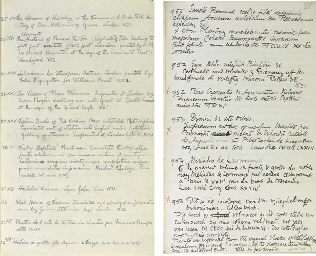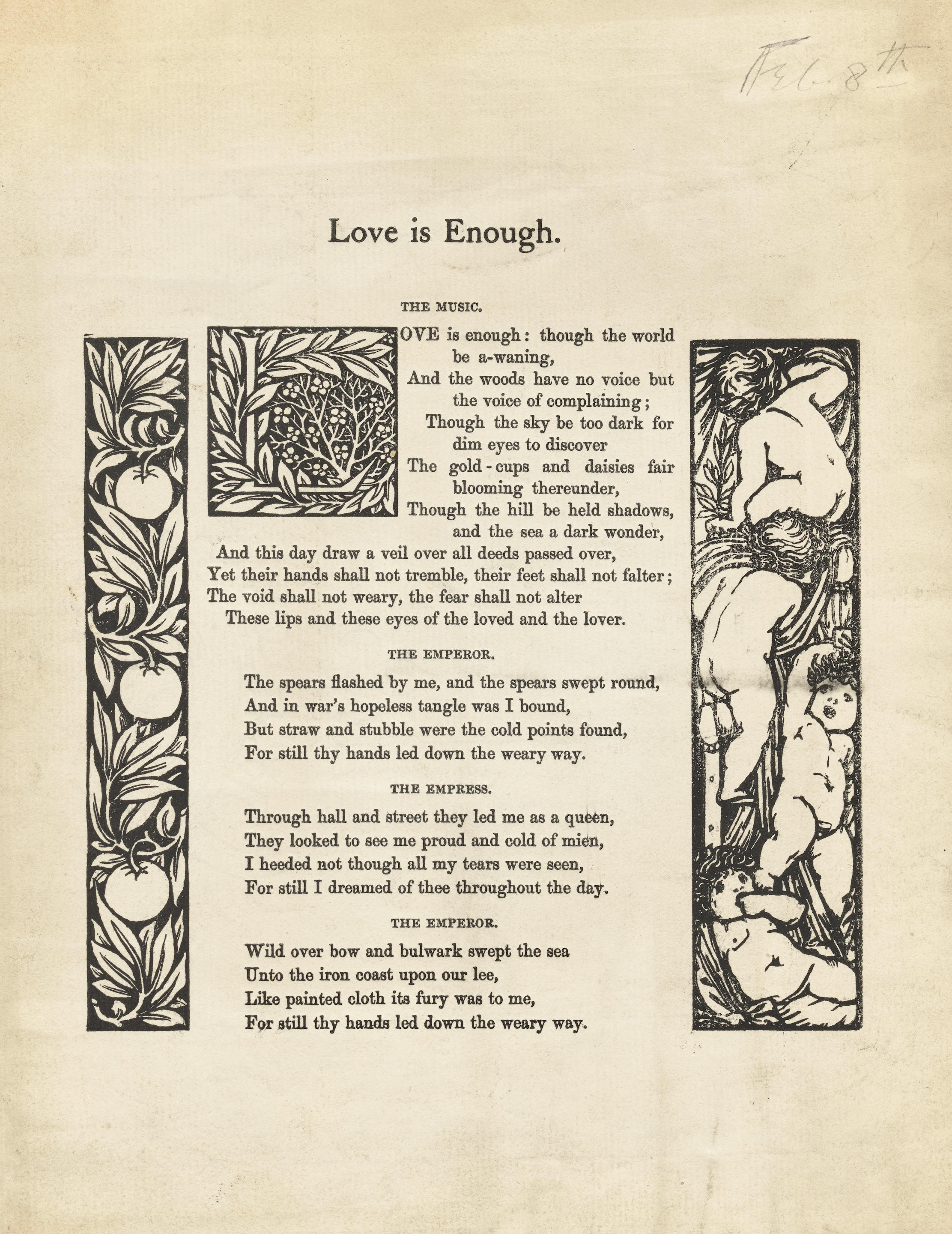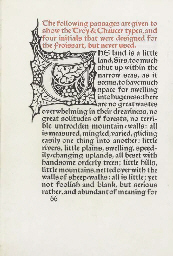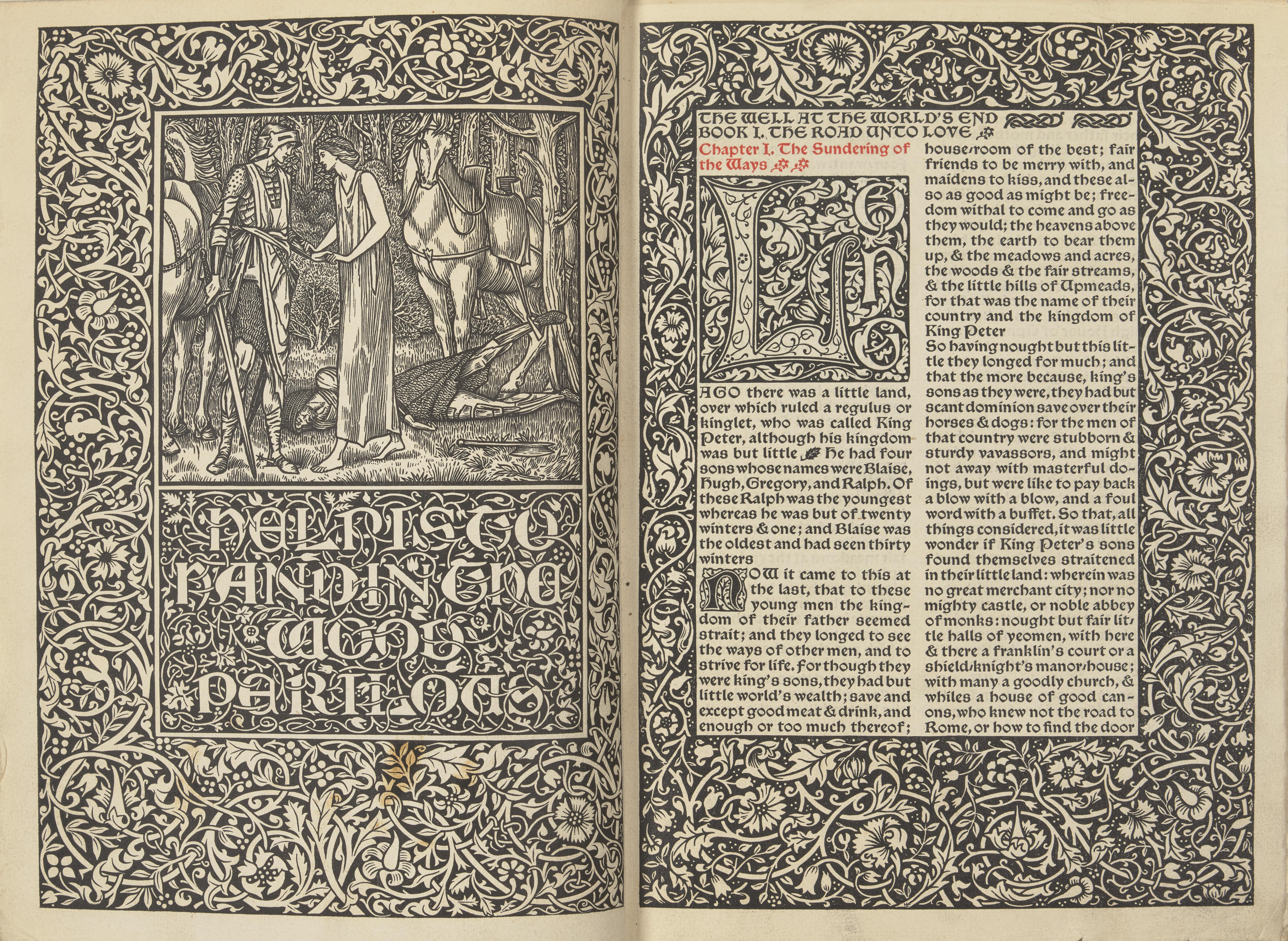BURNE-JONES, EDWARD. ARTIST. A Collection comprising the first trial wood-engraved illustration and 26 other unpublished trial illustrations, designed by Edward Burne-Jones for the unpublished work "Cupid and Psyche", and printed by William Morris [London: the woodblocks cut 1866-67, the trial leaf struck in 1866, and the proof illustrations printed by Morris c.1881.] The first trial illustration for Cupid and Psyche, the page annotated at lower left, "My first trial setting". In Morris' hand? Black ink on dark sepia paper. [1866]. Folio. Modern cloth folder. See The Story of Cupid and Psyche, London and Cambridge, 1974. Illustration number WM5. [Together with:] 26 trial woodcuts after Burne-Jones and cut and printed by William Morris printed by Morris himself for the abandoned early illustrated edition of the The Earthly Paradise, printed either in black or sepia inks, and comprising 20 different images struck on large size folio sheets, with 6 of the images on two different colored papers, all but 2 printed from blocks cut by Morris himself. The image of the singers, black on white arches, has a note ?in Morris's hand Used in the 1866 trial. Loose in a modern morocco backed cloth folder. The Story of Cupid and Pysche was only fully published in 1974, and in that text the different wood blocks were attributed to their makers. The illustrations in this collection comprise WM2,7,13,14,16,19,22,27(2), 29(2),30, 31,32,36,41,43(2),45(2), GFC9, GYW40 (2), and 3 others unassigned. An exceptionally rare series of trial strikes by William Morris experimenting with different inks and colored papers using Morris's own woodcuts that were excecuted for an abandoned Burne-Jones/Morris project. Cupid and Psyche was conceived in 1864 as part of a lavishly illustrated edition of stories from the Earthly Paradise, and over the next two years Burne-Jones worked on the project, making 55 drawings for the Cupid and Pysche story by the end of 1865. In 1866, a wood engraver was brought in to render the images onto woodcuts, but Morris, on seeing the first results, dismissed the engraver, and set about engraving the images himself for future publication. 44 of the Burne-Jones designs were cut onto wood blocks, around 35 of these by Morris himself, and a few by other wood engravers. A few pulls from these blocks were made at the Chiswick Press in 1866, and after that the project floundered, probably because of lack of funds. Morris kept the blocks all his life, believing that they would be a major project later on. We know that, at various times, Morris would bring them out and look at them again. Around 1881, Morris made several sets himself using frictional printing, and Emory Walker printed 8 other sets on batchelor paper after 1891. This set is part of one of the experimental sets printed by Morris himself, continuing his experiments using different inks and different colored papers, which he had started with in the illustrated Love is Enough edition of 1871. He tried to compare the result of a black ink and a sepia ink on the 3 different colored papers, white Arches paper, sepia Michallet, and buff Michallet paper, each creating a startlingly different result. The story of the Cupid and Pysche project does not end on Morris's death, as conversations between Burne-Jones and Cockerell in December 1896, resulted in plans for new plates to be made up from the original Burne-Jones drawings, and 7 specimen pages were printed in January 1897, but the project died with EBJ's death in 1898. See Peterson B6.
BURNE-JONES, EDWARD. ARTIST. A Collection comprising the first trial wood-engraved illustration and 26 other unpublished trial illustrations, designed by Edward Burne-Jones for the unpublished work "Cupid and Psyche", and printed by William Morris [London: the woodblocks cut 1866-67, the trial leaf struck in 1866, and the proof illustrations printed by Morris c.1881.] The first trial illustration for Cupid and Psyche, the page annotated at lower left, "My first trial setting". In Morris' hand? Black ink on dark sepia paper. [1866]. Folio. Modern cloth folder. See The Story of Cupid and Psyche, London and Cambridge, 1974. Illustration number WM5. [Together with:] 26 trial woodcuts after Burne-Jones and cut and printed by William Morris printed by Morris himself for the abandoned early illustrated edition of the The Earthly Paradise, printed either in black or sepia inks, and comprising 20 different images struck on large size folio sheets, with 6 of the images on two different colored papers, all but 2 printed from blocks cut by Morris himself. The image of the singers, black on white arches, has a note ?in Morris's hand Used in the 1866 trial. Loose in a modern morocco backed cloth folder. The Story of Cupid and Pysche was only fully published in 1974, and in that text the different wood blocks were attributed to their makers. The illustrations in this collection comprise WM2,7,13,14,16,19,22,27(2), 29(2),30, 31,32,36,41,43(2),45(2), GFC9, GYW40 (2), and 3 others unassigned. An exceptionally rare series of trial strikes by William Morris experimenting with different inks and colored papers using Morris's own woodcuts that were excecuted for an abandoned Burne-Jones/Morris project. Cupid and Psyche was conceived in 1864 as part of a lavishly illustrated edition of stories from the Earthly Paradise, and over the next two years Burne-Jones worked on the project, making 55 drawings for the Cupid and Pysche story by the end of 1865. In 1866, a wood engraver was brought in to render the images onto woodcuts, but Morris, on seeing the first results, dismissed the engraver, and set about engraving the images himself for future publication. 44 of the Burne-Jones designs were cut onto wood blocks, around 35 of these by Morris himself, and a few by other wood engravers. A few pulls from these blocks were made at the Chiswick Press in 1866, and after that the project floundered, probably because of lack of funds. Morris kept the blocks all his life, believing that they would be a major project later on. We know that, at various times, Morris would bring them out and look at them again. Around 1881, Morris made several sets himself using frictional printing, and Emory Walker printed 8 other sets on batchelor paper after 1891. This set is part of one of the experimental sets printed by Morris himself, continuing his experiments using different inks and different colored papers, which he had started with in the illustrated Love is Enough edition of 1871. He tried to compare the result of a black ink and a sepia ink on the 3 different colored papers, white Arches paper, sepia Michallet, and buff Michallet paper, each creating a startlingly different result. The story of the Cupid and Pysche project does not end on Morris's death, as conversations between Burne-Jones and Cockerell in December 1896, resulted in plans for new plates to be made up from the original Burne-Jones drawings, and 7 specimen pages were printed in January 1897, but the project died with EBJ's death in 1898. See Peterson B6.















Try LotSearch and its premium features for 7 days - without any costs!
Be notified automatically about new items in upcoming auctions.
Create an alert